
Times are tough. With rising food costs and growing expenses, shopping and preparing for countless meals and guests for the holidays is more difficult than ever. I’m on a mission to help! Together, with some pre-planning, smart thinking and budgeting, YES. WE. CAN. CHAG. L’chaim!
I started the hashtag #YesWeCanChag over on Instagram as a community initiative to help us all create delicious and holiday-worthy dishes this Chag on a budget. I believe that the High Holidays should be a time of reflection, introspection, joy and love. They shouldn’t have to be a time of stress – and it all starts with perspective. Why are we here? We’re here to bring our family and friends around the table to celebrate our traditions and heritage. It doesn’t matter what we serve, so much as how we serve it. Set a beautiful table. Set a beautiful tone (relax!). Make everyone comfortable. The food is secondary. Yes. You read that right.
So, realistically, how can one budget when there is meal after meal, night after night?
For starters, my fellow bloggers and I have put together a menu of budget-friendly recipes which you can download here!
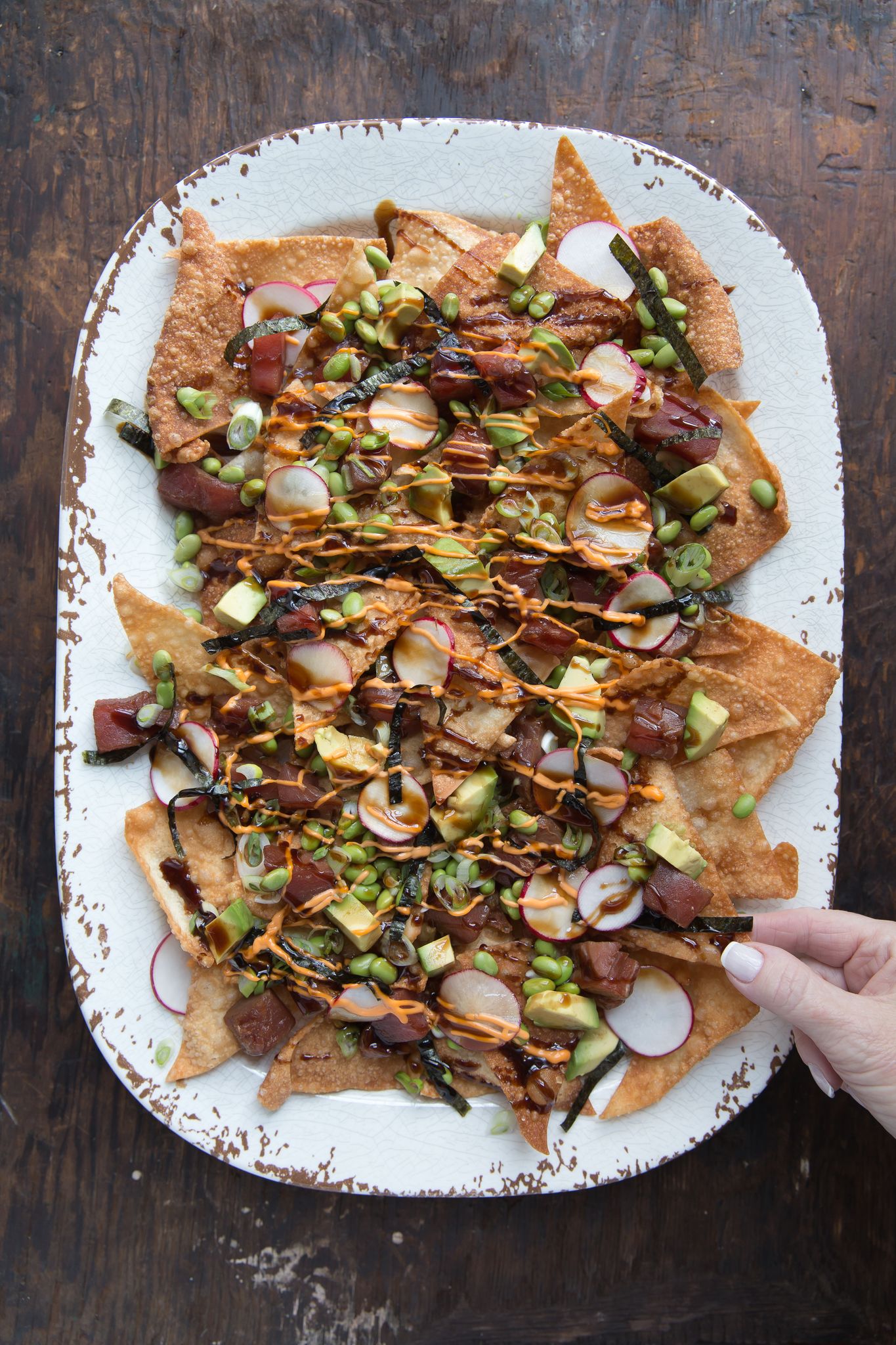 sushi nachos, Millennial Kosher, page 68
sushi nachos, Millennial Kosher, page 68
COMPOSE A BALANCED MENU
First things first, do away with the 3-4 course meals. No one can eat that much. It’s costly. It’s hard on the cook….There are so many reasons to scale back. Instead of a three course dinner with fish, multiple salads and dips, assorted proteins and sides and then dessert, serve a balanced meal without the fuss. To do this, imagine you’re in a restaurant – you order an appetizer – one or two at most, and then your main, which comes with a protein and two sides – then dessert. This is how you serve! So lets plan a holiday meal:
APPETIZER (choose 1-2): salad, assorted dips, hummus with toppings, sushi/tartare/crudo, nachos, tacos
ENTREE (choose 1 main, 1 starch and 1 vegetable or 1 main, 2 vegetables) : main (fish, chicken, meat), starch (rice, pasta, potatoes, couscous, farro), vegetable (cauliflower, asparagus, green beans, brussels sprouts, salad)
DESSERT: (choose 1) mousse, cake, cookies, fruit, sorbet, ice cream
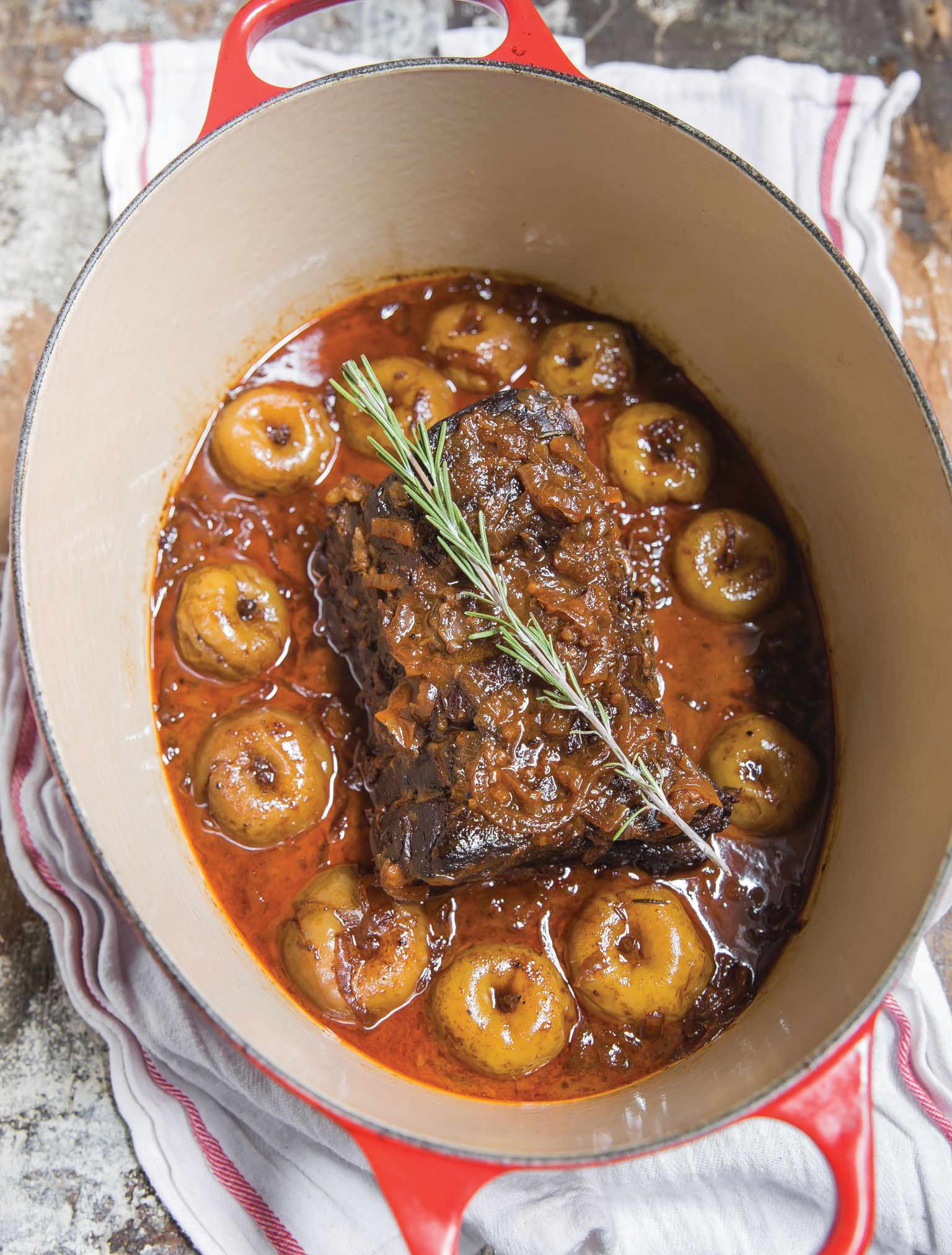 fall harvest roast, Millennial Kosher, page 182
fall harvest roast, Millennial Kosher, page 182
CHOOSE BUDGET FRIENDLY CUTS OF MEAT
Instead of following a recipe for a specific cut of meat, shop what’s on sale. Many cuts are interchangeable! The important thing to understand about how to cook meat is whether you DRY ROAST or BRAISE it. Tough cuts of meat require low and slow cooking in a braising liquid to help tenderize the meat, until it’s soft and falls apart. More tender cuts are cooked at high temperatures for a shorter period of time to firm up the muscles fibers. They’re usually served rare or medium rare, with a pink interior and a chewy texture. Therefore, if you are following a recipe for a braised brisket, but brisket is $21.99/lb., you can substitute a chuck eye roast at $15.99/lb. for any braised recipe. When it comes to braised meat – the simple rule to follow is that it’s ready when it’s fork tender – so put your fork in it and if it feels soft as butter, then it’s ready! If it’s still tough, keep cooking it for another hour, and check again. If you’re a meat novice, you’re definitely safer going with a braising cut, whereas dry roasted meat need more precision so as not to overcook (and a meat thermometer is recommended). It’s hard to overcook braised beef – 325 degrees for 3 hours is a good rule of thumb for a 3 lb. roast. Tougher cuts like 2nd cut brisket can sometimes use an additional hour or two.
Read my Guide to Purchasing and Preparing Kosher Meat for more information about different cuts of kosher meat. If you are unsure, ask your butcher if it’s a “braising” or “dry-roasting” cut.
Another great way to make the most of cheaper cuts of meat is to cook it in an instant pot/pressure cooker or to cook it sous vide – which tenderizes cheaper cuts.
Aside for purchasing budget friendly cuts, you can also get more bang for your buck by braising meat until pull-apart tender and then serving it in tacos, on a flatbread, or over nachos to stretch a small roast to serve many!
Additionally, you can get creative with the most budget-friendly cut – ground beef – and turn it into a festive appetizer or entrée. Some holiday-worthy ideas include: meatballs, single-serve empanadas or meat knishes with a mushroom sauce, spaghetti Bolognese, stuffed cabbage, shepherd’s pie, kofta kebabs, beef flatbread, moussaka.
THINK OUTSIDE THE BOX (OR BARN!)
You don’t need to make meat the star of every meal! Consider serving a dairy meal with shakshuka, frittata, quiche and a cheese board or serve a classic chicken paprikash with dumplings! You can do falafel or sushi in the sukkah. Themed meals are super fun over the course of the holiday.
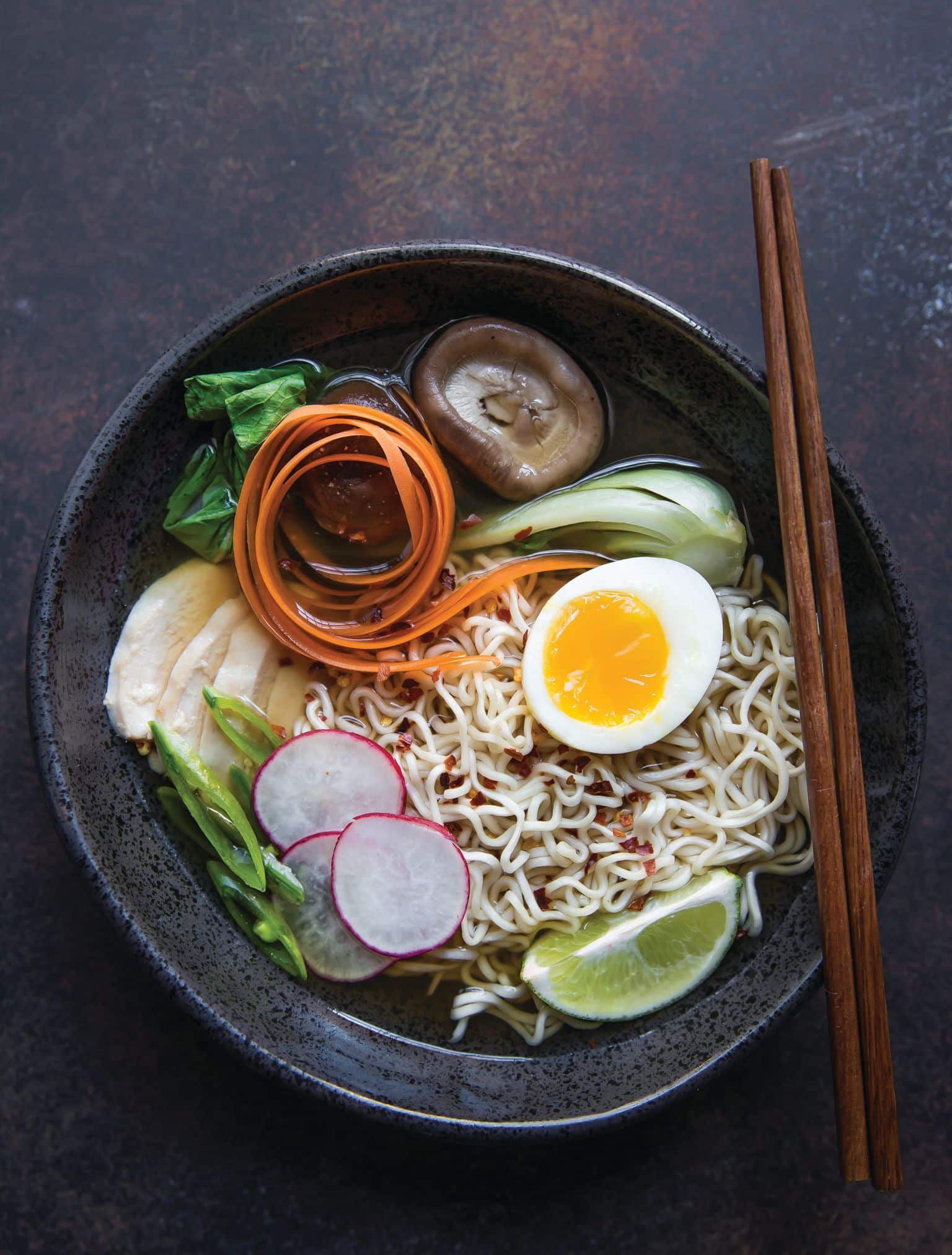 ramen bowls, Millennial Kosher, page 182
ramen bowls, Millennial Kosher, page 182
MAKE IT A ONE-DISH-MEAL
With so many holiday meals, you don’t have to be so formal. Consider a one-dish-meal one night in the sukkah – like build your own ramen bowls (you can even use leftovers here!), Yemenite chicken soup with freshly warmed pita, some schug and hummus, Unstuffed cabbage with little meatballs or a hearty mushroom barley soup.
REPURPOSE YOUR LEFTOVERS
With meal after meal during the Chagim, waste not! use leftovers to your advantage. Here are some ideas:
•leftover roast can become: nachos, tacos, bourekas, pulled beef pizza/flatbread, shepherd’s pie, pulled beef sandwiches, eggrolls, wontons
•leftover chicken can become: chicken pot pie, chicken tortilla soup, chicken tacos, ramen bowls, chicken Caesar salad, Pad Thai, chicken wraps
•leftover fish can become: sushi salad, fish patties, fish tacos, fish nachos, salmon pasta salad, summer rolls
•leftover rice can become: fried rice, rice pancakes, arancini, risotto, tomato rice soup, bibimbap
•leftover pasta can become: pasta salad, kugel, minestrone soup, Asian noodles
•leftover mashed potatoes can become: shepherd’s pie, bourekas, gnocchi
USE THIS NOT THAT
Remember that recipes are just guidelines, you don’t need to follow them to a T (unless you’re baking, then it’s another story!). Substitute cheaper ingredients when you can. For instance, instead of getting sushi grade tuna for sushi salad, consider using kani (mock crab sticks). Use barley instead of farro or apples instead of figs and sliced almonds instead of pine nuts.
SHOP ON SALE
Be flexible with your menu and buy what’s on special. Most types of white fish are interchangeable in recipes, and as mentioned above, you can substitute many cuts of meat in a recipe as well.
BUY SEASONAL PRODUCE
Seasonal produce is cheaper because it’s abundant and more local (when produce is out of season, they need to ship it in from tropical climates, making it more expensive).
HOST A POTLUCK
Invite over some neighbors or friends and have them bring a dish or two! Everybody wins!
Got more ideas for cooking Yom Tov on a budget? Comment with them below!

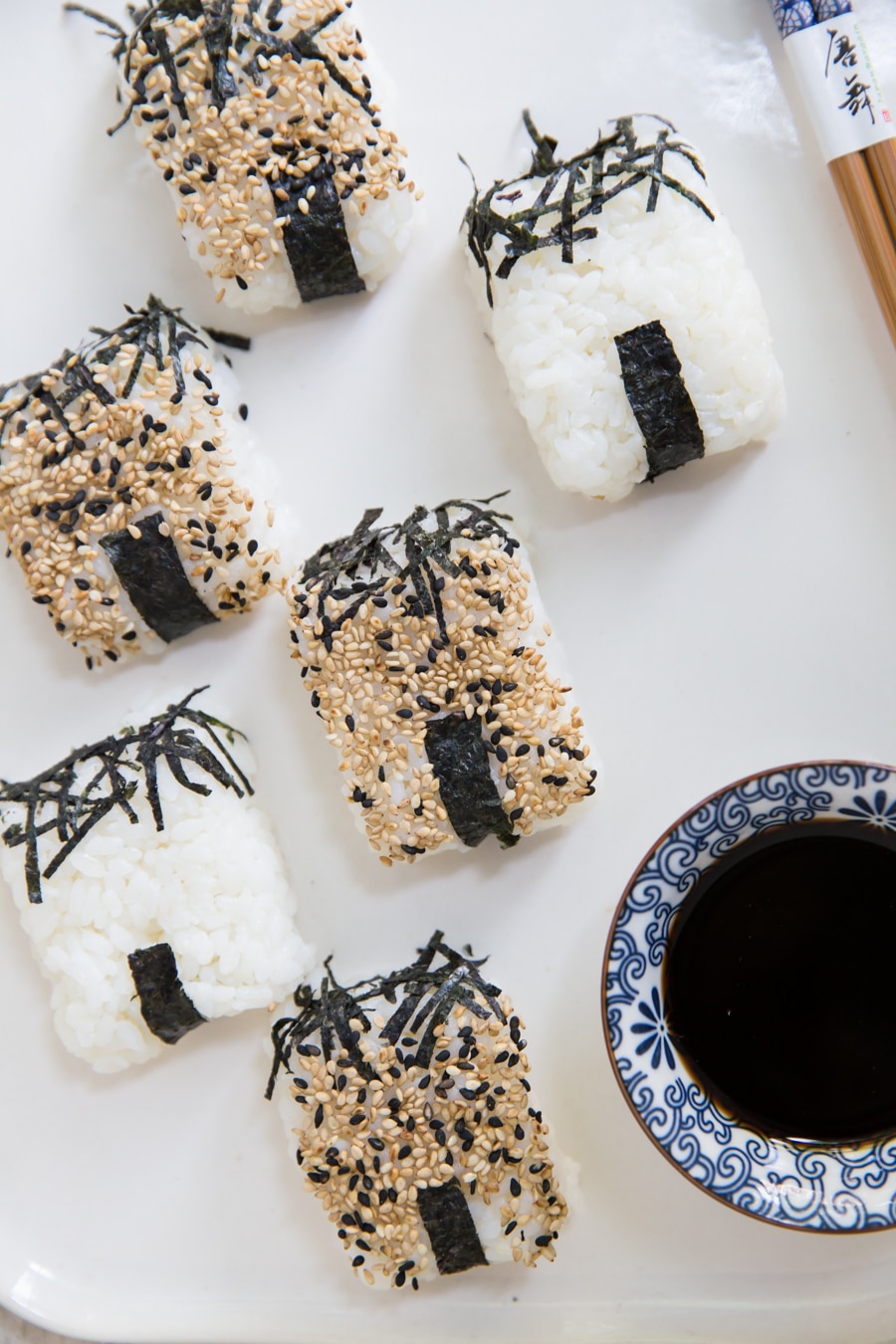
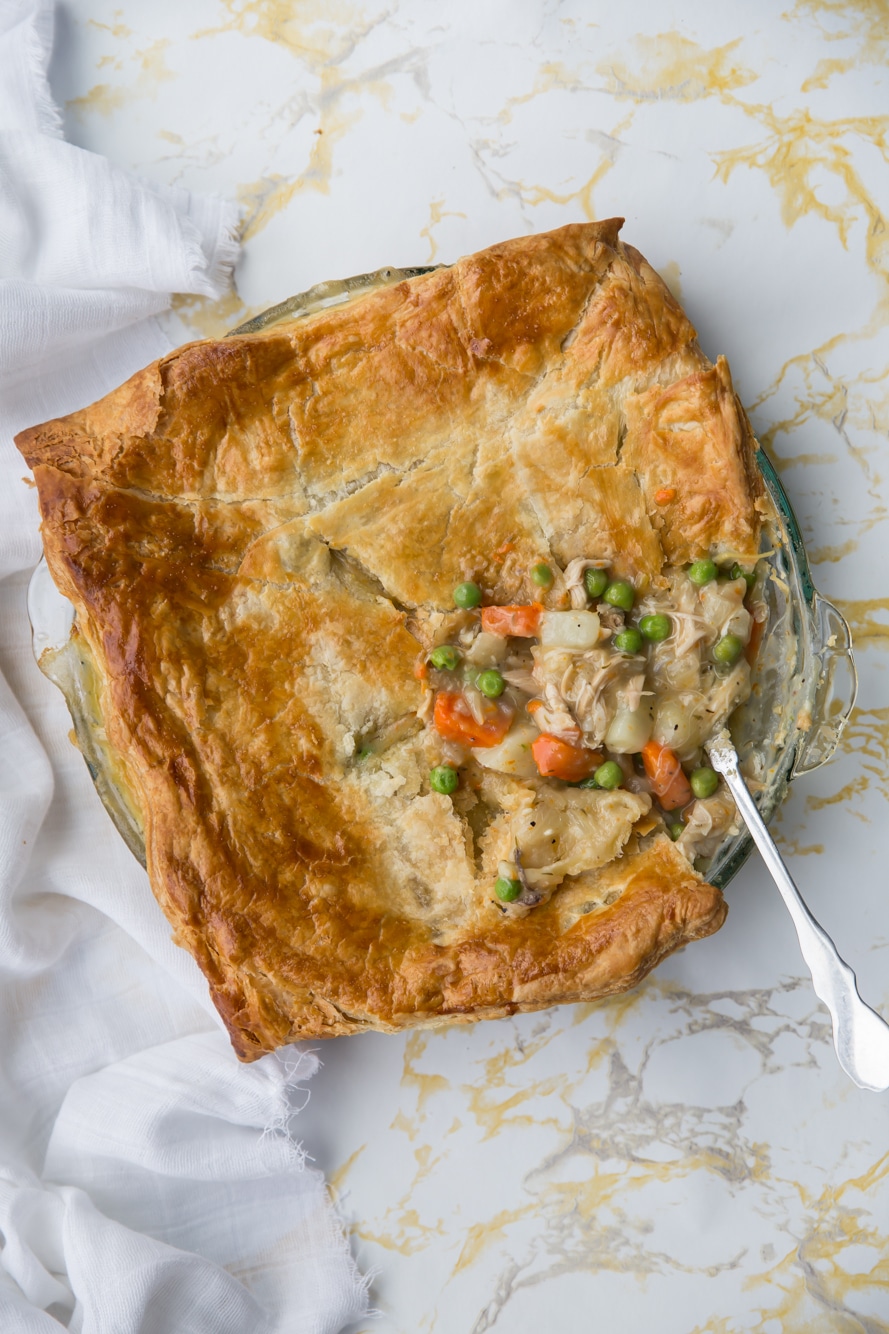
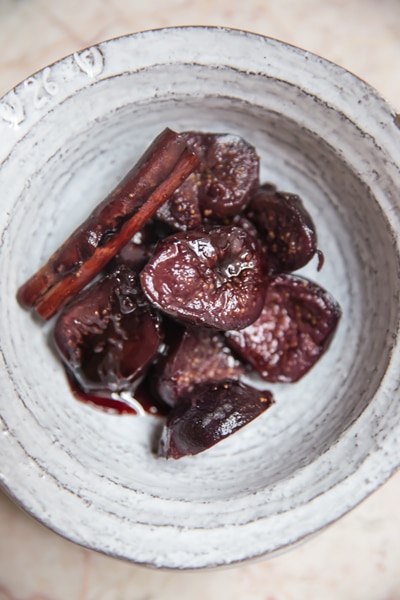
Great concept!
I love plating one of the courses. It really cuts out a lot of the workload since i have less pressure to have so many options.